Concept of Primate City and Rank-Size Rule | Geography Optional for UPSC PDF Download
Primate city
The concept of a Primate City is an empirical inductive model based on studies of 51 countries. This model was proposed by Mark Jefferson as a way to analyze a country's socio-economic conditions and overall development by examining its urbanization pattern. A Primate City is the largest and most prominent urban settlement in a country, which has grown disproportionately compared to other cities due to a concentration of economic opportunities, political power, industrial growth, factors of production, and the agglomeration effect.
- A Primate City acts as a significant economic magnet, attracting massive migrations and resources from its surrounding areas. Examples of primate cities include London and New York. These cities embody the socio-economic aspirations and experiences of a nation, reflecting its centripetal forces and ethnolinguistic unity.
- Primate cities also represent a strong national sentiment and the developing nature of an economy. Jefferson's study of 51 European countries found that 41 of them had primate cities, such as London in Britain, Paris in France, and Berlin in Germany. For instance, London is at least five times larger than the next largest city in Britain, Birmingham.
- However, not all countries exhibit a primate city pattern, as some have multiple comparable cities. Examples include India with its four megacities, Sydney and Melbourne in Australia, and Toronto and Montreal in Canada. Overall, the concept of a Primate City serves as a useful tool for understanding the level of development and urbanization of a country.
Process of Primate City development (Evaluation of theory)
The development process of primate cities was not identified by Mark Jefferson himself but was suggested by Linskey. According to Linskey, countries with primate cities tend to have the following characteristics: large population base, small territorial extent, high population density and growth rate, agriculture-based economy, low per capita income, and former colonial status. This implies that primate cities are usually found in developing countries. However, exceptions exist, such as India having primate cities despite its large territorial extent, and developed countries like Britain, Germany, and France also having primate cities.
Gunnar Myrdal's theory of cumulative causation provides a better explanation for the development process of primate cities. Myrdal suggests that a country's economic development generally goes through three stages:
- The first stage is characterized by a uniform level of development, albeit at a low level.
- In the second stage, a central geographical area attracts various factors of production such as capital, labor, and enterprises, and begins to grow disproportionately by draining resources from surrounding areas. This process, known as backwash, causes one city to act like a vacuum pump, drawing in all investments and technology at the expense of other cities.
- The third and final stage involves the dispersion and diffusion of development from the primate city, leading to the overall development of the entire region.
Primate cities offer better employment opportunities, higher wages, improved infrastructure, and the promise of a better life, attracting migration, commerce, and capital investments. A primate city can be defined as the most populous city in a country, with a population that is at least twice as large as the country's second-largest city.
In his study of 51 countries, Mark Jefferson found that the population of the largest city in 27 countries was more than double that of the second-ranking city, and in 18 countries, it was more than triple. Based on this observation, Jefferson concluded that a primate city is one with a population more than twice that of the second-ranking city. Therefore, the concept of a primate city is based on the relationship between the populations of the first- and second-ranking cities and the ratio between them.
Applicability of theory
- The Primate City theory is an inductive one, meaning it is based on observations and does not necessarily apply universally, as socioeconomic forces can greatly vary. In human geography, any law that deals with human behavior cannot be entirely objective, which means it will lack universal validity. This also holds true for the Primate City concept, as its applicability has varied relevance across different countries.
- For example, Mexico City is five times larger than the second-ranking city, Guadalajara. In Uruguay, the population ratio between Montevideo and Paysandú is greater than 7. However, in Canada, the population ratio between Montreal and Toronto is just slightly greater than 1. These examples demonstrate that the Primate City concept does not always hold true in every situation.
- Linskey attempted to identify the conditions that make the Primate City concept applicable, but even with these conditions, exceptions still exist. In conclusion, the Primate City theory is not a universally applicable concept, as it is greatly influenced by the dynamic nature of socioeconomic forces and human behavior.
Case of India
- In India, the concept of primate cities is not prevalent. Instead, the country exhibits multiple primacy due to various factors such as its large geographical extent, multi-ethnic and multi-lingual population, regional consciousness, and the development of four distinct megalopolises in different quadrants. The distance decay factor and the history of colonization in four different cities also contribute to this phenomenon. Additionally, the ratio of the largest city, Mumbai, to the second largest, Kolkata, is only 1.1, indicating a lack of primacy. The country's constitution grants citizens the right to settle anywhere, and being a federal state, primacy is more likely to be observed at the state level.
- In many states, the capital cities function as primate cities, although there are exceptions. For example, Uttar Pradesh, despite its low development status, has several large and comparable cities such as Varanasi, Allahabad, Lucknow, and Kanpur. This could be attributed to the state's vast size. Similarly, Tamil Nadu has Chennai, Madurai, and Coimbatore, with Chennai being the largest but not disproportionately so. This can be attributed to Tamil Nadu's better record in the distribution of development.
- In Kerala, a relatively more developed and smaller state, there is no primate city. Thiruvananthapuram, Kochi, and Calicut are all comparable in size and importance, likely due to the state's unique geography, consisting of hilly regions and a narrow coastal plain that does not confer any particular advantage or disadvantage to any specific area.
- However, in most other states, the capital cities serve as primate cities, such as Jaipur in Rajasthan, Bangalore in Karnataka, and Gandhinagar/Ahmedabad in Gujarat. Overall, India's diverse geography, culture, and political structure contribute to the absence of a single primate city at the national level, with primacy being more common at the state level.
State level primacy in India
- The study done by professor Qazi Ahmed in 1971
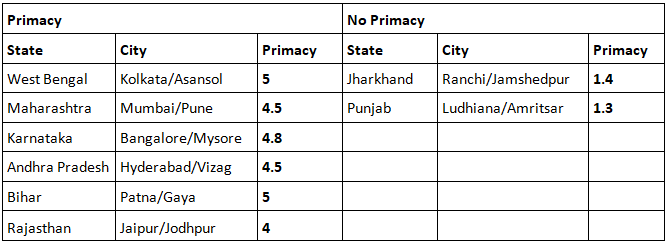
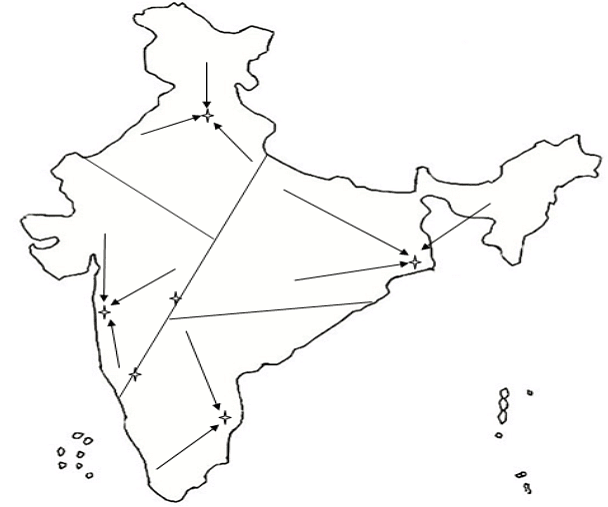
- The socio-economic analysis of states hardly reveals any trend. States with greater industrialization, growth of secondary sector have the tendency of greater primacy.
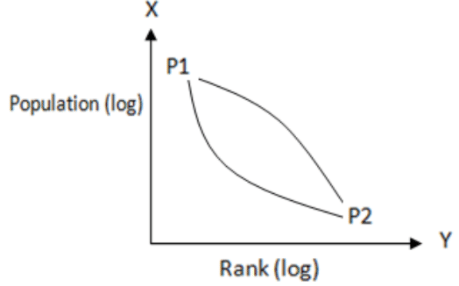


- Such theories are tested by two principles:
(i) Desirability
(ii) Applicability - Applicability: Humanistic model represents half truth, thus they are partially applicable, even then desirable because they are yardsticks to measure reality and deviation from it and causes from such deviation.
- Desirability
- Primacy can sometimes be seen as an example of inequality due to its tendency to concentrate resources and development in one area. As a result, urban planners generally tend to discourage primacy in their plans.
- However, there are situations in which primacy can be beneficial, such as when planning for a small territorial region with limited resources and investment. In these cases, concentrating development in one area can help to avoid duplication and inefficient use of resources that might occur if development is spread evenly across the region.
- In developing countries or poor regions, promoting primacy in the initial stages of development might be advantageous. This approach, referred to as deliberate imbalance-based planning, can help ensure that resources and investments are used efficiently during the early stages of growth.
- Overall, while primacy might be useful in certain circumstances and during the initial stages of development, it is essential to ensure that growth and development are eventually distributed more evenly to avoid perpetuating disparities in the long term.
Rank Size Rule
- The study of urban hierarchy and urban continuum was first conducted in 1914 by Auerbach, but as a theoretical law, it was presented in 1949 by G.K. Zipf.
- Both primate city and rank-size rule are discussions on urban hierarchy and both study hierarchy in terms of population size.
- One difference between the two is that the primate city discusses only the largest city and does not tell how it is related to other cities and towns whereas the rank-size rule does the same.
- Rank Size Rule is an idealistic inductive model based on a statistical analysis of several countries of their urban center and their size hierarchy.
- It seeks to understand the population relationship between cities of various ranks and also the urban continuum of a country.
- It analyses why cities in lower ranks are higher in number than the cities of higher ranks.
- The number of higher cities is much lower than the cities in the lower order.
- The largest cities have multiple functions and more diverse economic activities and they have much larger areas, thus their number is less.
- Rank Size Rule states that the population of the ‘nth’ city is ‘1/nth’ of the 1st rating city of a country.
- It may be numerically expressed as
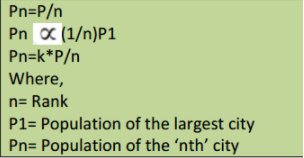
- The above relation is an exponential one. Thus, the population may be sequentially represented as:



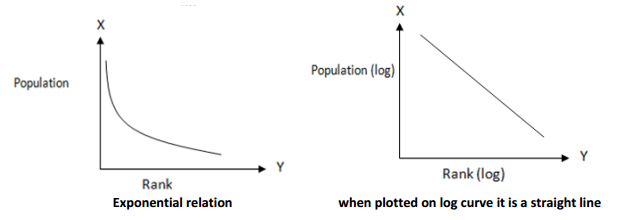
Implication of rank size rule and what does it depicts?
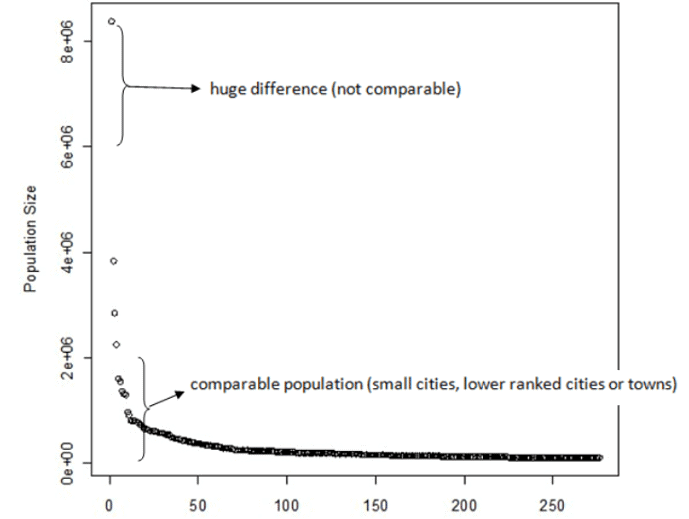
- In settlement system large cities are disproportionately large.
- Large cities are few in number (large cities are not comparable in size), whereas small towns and villages are numerous and they are of comparable size.
- In log curve Zipf was suggesting a normative ideal possibility in the straight line relationship. In reality there may be deviation as shown in graph.
- The straight line of the log function is actually an ideal state.
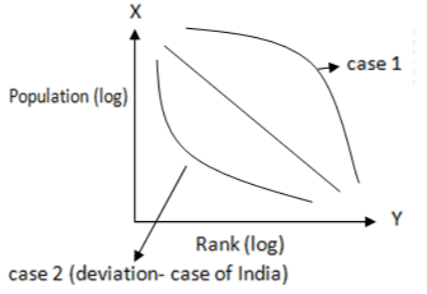
- There are 2 possible deviations.
- Case 1– In case-1 the deviation in the curve signifies that there is more than one city that is of comparable size (i.e. the possibility of more than one city comparable in size in the levels of upper hierarchy).
- Case 2– In case-2 deviation in the curve is an example of high primacy i.e. the largest city is much bigger and is a disproportionately large curve, so the Jefferson primate city concept is the special case in rank-size rule.
- Big cities are very few and have considerable variation in their disproportionate sizes whereas smaller settlements, towns, and villages are numerous and maybe all of the comparable sizes.
- In Ireland the primacy is shown by the city Belfast, which is proportionally very large than other cities of Ireland, but other cities and towns of Ireland follow rank size rule appreciably.
- Rank size rule envisages existence of high number of urban centres where landscape is fully developed and city functions are well distributed.
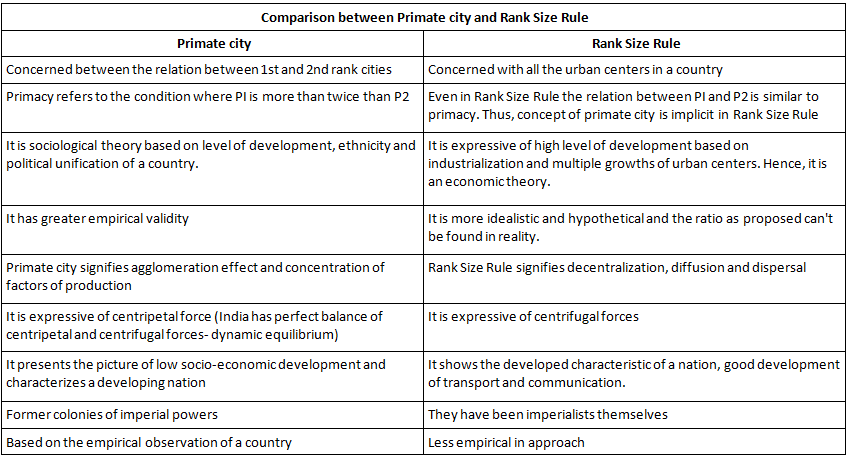
Rank Size Rule in India
Qazi Ahmed has utilized the Rank Size Rule to categorize states in India into two groups:
- States adhering to the Rank Size Rule: These states exhibit no primacy and follow the rule, including Punjab, Uttar Pradesh, Haryana, and Kerala.
- States not adhering to the Rank Size Rule: At the national level, India displays multiple primacies, which results in the Rank Size Rule not being applicable.
Conclusion
In conclusion, the concepts of Primate City and Rank Size Rule serve as useful tools for analyzing urban hierarchies, population distribution, and development patterns in various countries. While these inductive models are not universally applicable, they offer valuable insights into the socio-economic conditions and urbanization processes of different regions. India, with its diverse geography, culture, and political structure, presents a unique case where multiple primacies exist, and the Rank Size Rule is not uniformly followed across states. Understanding these urban patterns can help inform urban planning and development strategies to ensure a more balanced and sustainable growth for countries and their cities.Frequently Asked Questions (FAQs) of Concept of Primate City and Rank-Size Rule
What is a Primate City?
A Primate City is the largest and most prominent urban settlement in a country that has grown disproportionately compared to other cities due to factors such as economic opportunities, political power, industrial growth, and the agglomeration effect.
What is the Rank Size Rule?
The Rank Size Rule is an idealistic inductive model that seeks to understand the population relationship between cities of various ranks and the urban continuum of a country. It states that the population of the 'nth' city is '1/nth' of the 1st ranking city of a country.
How does the Primate City concept differ from the Rank Size Rule?
The Primate City concept focuses on the largest city and its disproportionate growth compared to other cities in a country, while the Rank Size Rule aims to understand the population relationship between cities of various ranks and the urban continuum of a country.
Can the Primate City theory be applied universally?
No, the Primate City theory is not a universally applicable concept, as it is greatly influenced by the dynamic nature of socioeconomic forces and human behavior. It serves as a useful tool for understanding the level of development and urbanization of a country but does not hold true in every situation.
Does India follow the Primate City concept or the Rank Size Rule?
At the national level, India displays multiple primacies, which results in the Rank Size Rule not being applicable. However, at the state level, some states follow the Rank Size Rule, while others exhibit primacy with their capital cities serving as primate cities.
|
304 videos|717 docs|259 tests
|
FAQs on Concept of Primate City and Rank-Size Rule - Geography Optional for UPSC
| 1. What is a primate city? |  |
| 2. How is a primate city determined? |  |
| 3. What are the characteristics of a primate city? |  |
| 4. What is the rank-size rule? |  |
| 5. How does the concept of primate city relate to the rank-size rule? |  |





















